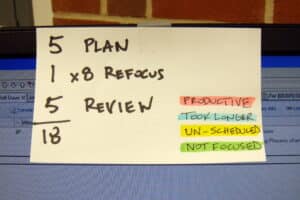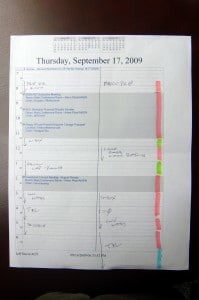 IN A NUTSHELL: A simply daily planning and review habit can dramatically increase your productivity and execution, for an investment of only 18 minutes per day. IN A NUTSHELL: A simply daily planning and review habit can dramatically increase your productivity and execution, for an investment of only 18 minutes per day. |
Allow me let you in on a couple of things about myself:
I am very task, detail, and plan oriented when I manage or review large projects at work. I insist on seeing detailed execution plans and Gantt Charts and am always asking “How long is it going to take?”, “When are you going to start?”, and “When will you be finished?”. Detail oriented to a fault.
I am also pretty diligent about my own personal planning systems and have been a pretty devoted Getting Things Done practitioner for the last 3 – 4 years. I have a pretty robust trusted system in Lotus Notes based around Eric Mack’s great eProductivity software which tracks all my work and personal projects and all of the next actions required to get those projects completed.
But somehow I never really connected those two sides of my psyche to apply my detailed project planning bent to the ways I actually schedule my work on a daily basis. I just never really made the link to the need for personal planning discipline and rigor at a granular level somehow, and I frequently felt like I didn’t get as much done in a 12 hour day as I should have / could have. I had a bit of a revelation when I read Peter Bregman’s “An 18-Minute Plan For Managing Your Day”, which speaks about a simple, obvious ritual for planning your day’s time and reviewing your day’s accomplishments. (Basically spend a total of 18 minutes planning and tracking your day: 5 minutes at the outset to plan the day, 1 minute at the top of every hour to review progress and recalibrate, and 5 minutes at the end of the day to review the day.) I tried it for several days, and it’s so simple that it actually worked. So then I tweaked the process a little bit, introducing some low-tech mind-tricks to help ensure that I would be able to make the habits stick.
My basic daily planning ritual is outlined below:
- Jedi Mind Hack #1: I designed and built a sophisticated reminder system which I then integrated into my computer display monitor. (A 3×5 index card with a basic reminder about the 18 minute commitment, scotch tape hinged to the top of my monitor.) Every night when I leave the office, I flip this down so that it’s the first thing I see when I power up in the morning. Whenever I leave for a meeting, I flip it down as I’m turning off the lights in my office, so that I’m reminded when I return.

- Each night before I leave the office, I print out the “Daily View” of my calendar, so that it’s there for me when I arrive the next day, and I can work on my daily plan while my computer is booting up.
- When I arrive in the morning, I spend the first 5 minutes or so planning out the day based on how much white space I have in between meetings. This is the key part that I never really grasped before. You have to plan something and schedule it if you really want to maximize your chance of actually doing it. How much time is available in my day in contiguous free time blocks? What are the key next actions on my “Do Today” list? (The Today flag is a great GTD tweak implemented in eProductivity, by the way.) Which can I really knock out today? How long should each task take if I really focus? When do I want to start and finish? I draw a line dividing my daily calendar printout into a left and right side, and pencil in my Plan for the day on the left, fitting my tasks into the available time windows. A key point is being as realistic as possible about how long things will actually take. Time is a finite constrained resource; Set yourself up to be successful and don’t unrealistically over-commit your day.

- I carry this printout around with me all day in my journal.
- Every hour, I glance at it for a minute or two and document on the right half of the page what I Actually worked on during the last 60 minutes. I know a lot of people have espoused the benefits of time journals, but it is a useful technique for helping you understand where your time goes. My print format breaks each hour into 15 minute blocks and I track my time granularly down to these quarter hour increments. It’s pretty important to do this frequently throughout the day if you want to have a hope of remembering what actually happened when. I find that the 2 – 3 minutes while a meeting is waiting to get started is a good time to do your hourly 1 minute relook. Capture anything over about 15 minutes: Capture the 15 minute unplanned discussion in the hallway, or the 30 minute call you ended up having to make or the fact that the meeting scheduled for 60 minutes actually went 75 minutes. You planned on having that time, and you lost it as a free time block. This isn’t necessarily a bad thing but it does cause you to adjust your plan for the day.
- Jedi Mind Hack #2: Highligters. They’re fun. They’re colorful. Colorful and fun things help reinforce behaviors if you still have a persistent inner child. I categorize my actual time usage under four very rough categories along the right margin of my daily schedule print:
- Pink: Productive Time, Great Work, Getting Things Done.
- Blue: Productive Time, but a Schedule overrun, tasks or meetings that took longer than scheduled or budgeted.
- Yellow: Un-Scheduled Drop-Ins. These are the miscellaneous crises and last minute meetings and discussions which can eat a tremendous part of your day’s white space sometimes.
- Green: Un-Focused Time. This is that black hole of mystery time, that just evaporates, unfortunately without leaving much of a trail of productive accomplishment in it’s wake. You may be distracted playing on the web, or you may just be trying to work on something productively but for some reason spinning your wheels. Take a walk, clear your head, and try again. Tracking this available capacity leakage is a key part of getting more done.
- At the end of the day, spend five minutes reviewing your actual time spent versus your planning budget from 12 hours ago. Think about what could have caused you to go green and lose productive time, or about how you could have minimized some of the unscheduled interruptions. Consider why you may be one who insists on packing 10 pounds of work into a 5 pound bag. Save your printouts and see if you find persistent daily patterns (i.e. Great Work early in the morning, Loss of focus after lunch, etc.) Adopt your daily planning accordingly.
Everyone’s different. You may not need this level of rigor in your daily execution. You may be disciplined enough to get stuff done without well-grooved habits and mind tricks. But for me, this approach helped a lot, kept me focused and allowed me to dynamically reallocate my schedule during the day based on changing priorities or unplanned but urgent activities. As always, your mileage may vary, but please let me know in the comments your experience if you try or use some variant of this approach.
Great tips. Thanks for sharing your personal productivity tools with us. – WYG
YongGuo – Thanks for stopping by and glad you can get some benefit. My method probably doesn't work for everyone but it helps me!!
Great article, Jeff. I enjoyed your creative visual tricks for staying focused, especially the 3×5 card. I definitely also felt convicted about my wasted “Green” time that flitters away… thanks for tugging at my conscience! 🙂
Thanks Ryan, glad you found it useful. I find that a good mix of “high-tech” (eProductivity) and “low-tech” (3×5 index cards) works well for me.
Great article, Jeff. I enjoyed your creative visual tricks for staying focused, especially the 3×5 card. I definitely also felt convicted about my wasted “Green” time that flitters away… thanks for tugging at my conscience! 🙂
Thanks Ryan, glad you found it useful. I find that a good mix of “high-tech” (eProductivity) and “low-tech” (3×5 index cards) works well for me.